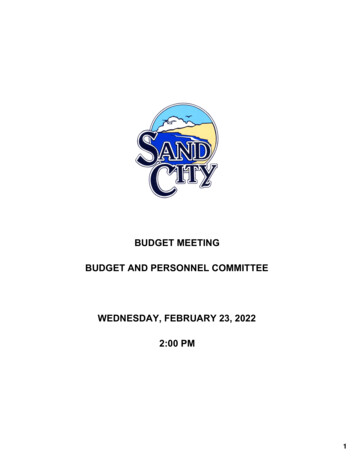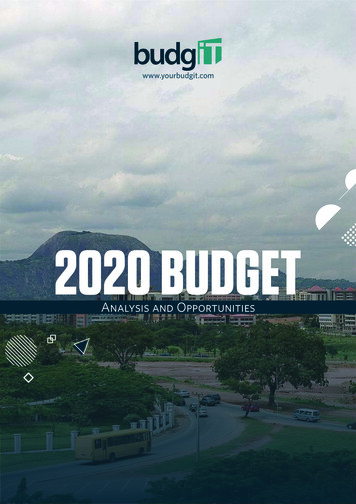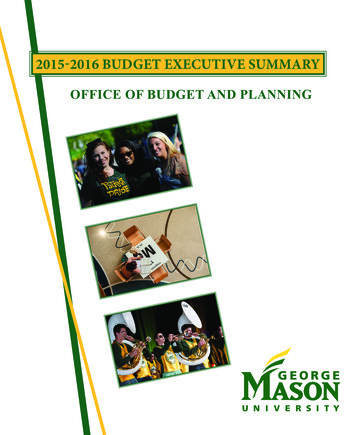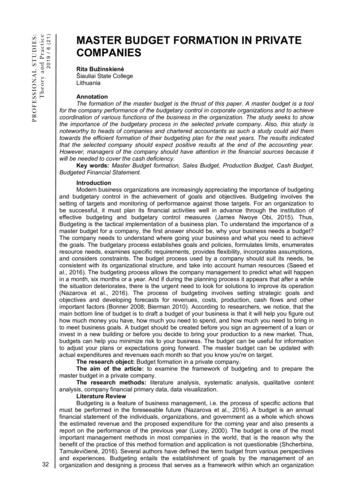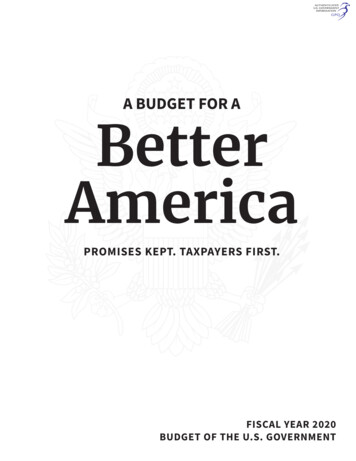
Transcription
A BUDGET FOR ABetterAmericaPROMISES KEPT. TAXPAYERS FIRST.FISCAL YEAR 2020BUDGET OF THE U.S. GOVERNMENT
THE BUDGET DOCUMENTSBudget of the United States Government,Fiscal Year 2020 contains the Budget Message ofthe President, information on the President’s priorities, and summary tables.Analytical Perspectives, Budget of the UnitedStates Government, Fiscal Year 2020 containsanalyses that are designed to highlight specifiedsubject areas or provide other significant presentations of budget data that place the budget in perspective. This volume includes economic and accountinganalyses; information on Federal receipts and collections; analyses of Federal spending; information onFederal borrowing and debt; baseline or current services estimates; and other technical presentations.Supplemental tables and other materials thatare part of the Analytical Perspectives volumeare available at ives/.Appendix, Budget of the United StatesGovernment, Fiscal Year 2020 contains detailedinformation on the various appropriations and fundsthat constitute the budget and is designed primarilyfor the use of the Appropriations Committees. TheAppendix contains more detailed financial information on individual programs and appropriationaccounts than any of the other budget documents.It includes for each agency: the proposed text of appropriations language; budget schedules for eachaccount; legislative proposals; narrative explanations of each budget account; and proposed generalprovisions applicable to the appropriations of entireagencies or group of agencies. Information is also6-095071-1950711provided on certain activities whose transactionsare not part of the budget totals.Major Savings and Reforms, Fiscal Year2020, which accompanies the President’s Budget,contains detailed information on major savings andreform proposals. The volume describes both majordiscretionary program eliminations and reductionsand mandatory savings proposals.BUDGET INFORMATION AVAILABLE ONLINEThe President’s Budget and supporting materials are available online at https://www.whitehouse.gov/omb/budget/. This link includes electronic versions of all the budget volumes, supplemental materials that are part of the Analytical Perspectivesvolume, spreadsheets of many of the budget tables,and a public use budget database. This link also includes Historical Tables that provide data on budgetreceipts, outlays, surpluses or deficits, Federal debt,and Federal employment over an extended time period, generally from 1940 or earlier to 2020 or 2024.Also available are links to documents and materialsfrom budgets of prior years.The budget documents and other supplementalmaterials included at this link were previously included on the Budget CD-ROM, which is no longermade available.For more information on access to electronic versions of the budget documents, call (202) 512-1530in the D.C. area or toll-free (888) 293-6498. To purchase the printed documents call (202) 512-1800.GENERAL NOTES1. All years referenced for budget data are fiscal years unless otherwise noted. All years referenced for economicdata are calendar years unless otherwise noted.2. At the time the Budget was prepared, five of the annual appropriations bills for 2019 had been enacted(the Energy and Water Development and Related Agencies Appropriations Act, 2019; the Legislative BranchAppropriations Act, 2019; the Military Construction, Veterans Affairs, and Related Agencies AppropriationsAct, 2019; the Department of Defense Appropriations Act, 2019; and the Departments of Labor, Healthand Human Services, and Education, and Related Agencies Appropriations Act, 2019). The programs andactivities provided for in the seven remaining 2019 annual appropriations bills were operating under acontinuing resolution (Public Law 115-245, as amended). For these programs, references to 2019 spendingin the text and tables reflect the levels provided by the continuing resolution (except for the Major Savingsand Reforms (MSV) volume which was written following enactment of all appropriations and reflects 2019enacted for all programs).3. Detail in this document may not add to the totals due to rounding.U.S. GOVERNMENT PUBLISHING OFFICE, WASHINGTON 201990000For sale by the Superintendent of Documents, U.S. Government Publishing OfficeInternet: bookstore.gpo.gov Phone: toll free (866) 512-1800; DC area (202) 512-1800Fax: (202) 512-2104 Mail: Stop IDCC, Washington, DC 20402-0001I S B N 978-0-16-095071-1
Table of ContentsPageThe Budget Message of the President 1A Budget for a Better America 5Modernizing Government 7Cutting the Red Tape: Unleashing Economic Freedom 13Department of Agriculture 15Department of Commerce 19Department of Defense 23Department of Education 29Department of Energy 35Department of Health and Human Services 39Department of Homeland Security 49Department of Housing and Urban Development 53Department of the Interior 57Department of Justice 61Department of Labor 65Department of State and Other International Programs 71Department of Transportation 77Department of the Treasury 81Department of Veterans Affairs 85Corps of Engineers—Civil Works 89Environmental Protection Agency 93National Aeronautics and Space Administration 97Small Business Administration 101Summary Tables 105OMB Contributors to the 2020 Budget 141
THE BUDGET MESSAGE OF THE PRESIDENTTo the Congress of the United States:In just over 2 years, together with the American people, we have launched an unprecedentedeconomic boom. Since I was elected, we have created more than 5 million new jobs, includinghalf a million manufacturing jobs. Nearly 5 million Americans have been lifted off food stamps.Unemployment is the lowest in nearly half a century. African American unemployment, HispanicAmerican unemployment, and Asian American unemployment rates have all reached historic lows.Our Nation is experiencing an economic miracle—and it is improving the lives of all our citizens.We have achieved these extraordinary gains thanks to historic tax cuts and an unprecedentedregulatory reduction campaign, through unleashing American energy production, systematicallyfixing bad trade deals, and remaining absolutely committed to putting the needs of the Americanworker first.My Administration worked with the Congress to pass unprecedented legislation to confront theopioid crisis, a sweeping new farm bill, groundbreaking criminal justice reform, major investmentsto rebuild the military, and historic Department of Veterans Affairs reforms to ensure that our greatveterans have access to high quality healthcare.We are also making our communities safer. To target violent crime, my Administration has increased support for Federal, State, and local law enforcement. We have added nearly 200 newviolent crime prosecutors across the United States. And last year, the Department of Justice prosecuted more violent crimes than ever before. As a result, violent crime is falling.My Administration is confronting the national security and humanitarian crisis on our southernborder, and we are accepting the moral duty to create an immigration system that protects the livesand jobs of our citizens. This includes our obligation to the millions of immigrants living in theUnited States today who followed the rules and respected our laws.In the 20th century, America saved freedom, transformed science, and defined the middle classstandard of living. Now we must write the next chapter of the great American adventure, turbocharging the industries of the future and establishing a new standard of living for the 21st century.An amazing quality of life for all of our citizens is within reach. We can make our communities safer,our families stronger, our culture richer, our faith deeper, and our middle class bigger and moreprosperous than ever before.We are now addressing our challenges from a position of strength. My 2020 Budget builds on thetremendous progress we have made and provides a clear roadmap for the Congress to bring Federalspending and debt under control. We must protect future generations from Washington’s habitualdeficit spending.1
2The Budget Message of the PresidentThis year, I asked most executive departments and agencies to cut their budgets by at least 5 percent. In addition to reflecting those reductions, my Budget invests in the following priorities:Securing our Borders and Protecting our Sovereignty. As President, my highest duty isthe defense of our Nation—which is why finishing the border wall is an urgent national priority. Allwho are privileged to hold elected office must work together to create an immigration system thatpromotes wage growth and economic opportunity, while preventing drugs, terrorism, and crime fromentering the United States. Immigration policy, like all policy, must serve the interests of Americansliving here today—including the millions of new Americans who came here legally to join our nationalfamily. The American people are entitled to a strong border that stops illegal immigration, and aresponsible visa policy that protects our security and our workforce. My Budget continues to reflectthese priorities, and I look forward to working with the Congress to finish the border wall and build asafe, just, and lawful immigration system that will benefit generations of Americans to come.Preserving Peace through Strength. A strong military, fully integrated with our allies and allour instruments of power, enables our Nation to deter war, preserve peace, and, if necessary, defeataggression against United States interests. To that end, my Budget requests 750 billion for nationaldefense, an increase of 34 billion, or 5 percent, from the 2019 enacted level. The Budget funds theNational Security Strategy and National Defense Strategy, building on the major gains we have already made throughout the world.Protecting our Veterans. Our Nation’s brave warriors and defenders deserve the best careAmerica has to offer—both during and after their active service. Last year, I signed into law the historic VA MISSION Act of 2018 to reform and transform the Department of Veterans Affairs healthcare system into an integrated system for the 21st century. My Budget fully funds all requirementsfor veterans’ healthcare services and provides additional funding to implement the VA MISSION Actof 2018.Investing in America’s Students and Workers. To help protect taxpayer dollars, my Budgetcontinues my request to create an educational finance system that requires postsecondary institutions that accept taxpayer funds to have skin in the game through a student loan risk-sharing program. My Administration will also continue to seek expanded Pell Grant eligibility for high-quality,short-term programs in high-demand fields, so that students and workers can quickly gain valuableskills at a more affordable cost and obtain family-sustaining jobs. We must create and invest in better opportunities for our Nation’s students and job seekers, while ensuring that we do so in a moreefficient and effective manner.Research for Childhood Cancers. Many childhood cancers have not seen new therapies in decades. My Budget initiates a new effort that invests 500 million over the next 10 years to supportthis critical life-saving research.Defeating HIV/AIDS in America. The HIV epidemic still plagues our Nation, with more than38,000 Americans infected every year. In response, my Budget provides 291 million to the Departmentof Health and Human Services to defeat the HIV/AIDS epidemic. The goal is to eliminate most newinfections within 5 years (75 percent) and nearly all within 10 years (90 percent). This initiative willfocus efforts on diagnosis, prevention, and treatment efforts in the locations where intense transmissions of the virus are driving the epidemic.Confronting the Opioid Epidemic. My Budget continues historic levels of funding for our lawenforcement, prevention, and treatment efforts to combat the opioid and drug addiction epidemic.
THE BUDGET FOR FISCAL YEAR 20203Supporting Working Families. America must also lead in supporting the families of our workforce so that they can balance the competing demands of work and family. My Budget includes aone-time, mandatory investment of 1 billion for a competitive fund aimed at supporting underserved populations and stimulating employer investments in child care for working families. MyAdministration has also pledged to provide paid parental leave to help working parents, and we arecommitted to partnering with the Congress to enact this important policy.******We must always strive to uphold our oaths to promote and protect the personal and economic freedoms the Constitution guarantees to us all.We must work together to renew the bonds of love and loyalty that link us to one another—asfriends, as citizens, as neighbors, as patriots, and as Americans.My Budget reflects my Administration’s commitment to these worthy goals as it seeks to makethe United States of America wealthier, stronger, safer, and greater for every American family andneighborhood.DONALD J. TRUMPThe White House,March 11, 2019
A BUDGET FOR A BETTER AMERICAOver the past two years, the President hasrestored faith in the American dream and extended a more prosperous future—an Americanfuture—that is secure, sovereign, and affordable.The President’s pro-growth economic agenda, MAGAnomics, has unleashed the Americaneconomy. Working alongside Republicans in theCongress, the President signed historic tax reform into law, marking the first time in morethan 30 years that the Nation’s tax laws wereoverhauled to provide much-needed relief toAmerican Families, all while allowing U.S. smallbusinesses to flourish. Unemployment is thelowest in 50 years, millions of jobs have been created, and GDP grew by 3.1 percent over the fourquarters of 2018. For the first time in history,there are more vacant jobs than job seekers tofill them. The economic health of the Nation is asstrong as it has ever been.The Administration’s ongoing efforts to cut redtape are also key to continued economic growth.Over the past year, Federal agencies have eliminated 12 unnecessary or duplicative regulationsfor every one new regulation implemented, whichhas saved the economy more than 23 billionin Washington-imposed costs. The President’sderegulatory efforts are providing relief for allAmericans through real wage growth and morejobs, ushering in a new era of optimism. Theweight of Washington’s presence is now a moredistant memory, and Americans feel confident toinvest in their families, businesses, and future.However, for economic growth to endure,Washington must fix its longtime spending problem, which has driven the Nation’s debt to morethan 22 trillion this year. Even with high levelsof economic growth, excessive deficits continueto threaten the Nation’s progress, and any unforeseen shocks to the economy could make deficits unsustainable. Without action to restore theproper size and role of the Government, deficitswill remain over a trillion dollars per year for theforeseeable future. Debt, already run up by theexcesses of previous administrations’ economicpolicies, will soon surpass a percent of GDP notseen since 1947.If financial obligations continue to grow at thecurrent pace, the Nation’s creditors may demandhigher interest rates to compensate, potentiallyleading to lower private investment and a smaller capital stock, harming both American businesses and workers. If nothing is done, interestpayments alone on the Federal Government’sdebt will double by 2023 and exceed spending onthe U.S. military by 2024.Even with a booming economy, excludingSocial Security and Medicare spending and revenues, the Federal Government is still runninga net deficit of 608 billion. During the GreatRecession, this figure increased from 664 billion in 2008 to 1,354 billion in 2010, illustratingwhat can happen during changes in the businesscycle when there is a complete lack of fiscal restraint. Since the end of the recession, little hasbeen done to rein in excessive spending as netdeficits averaged 759 billion from 2010–2016.The President is committed to protecting andrespecting American taxpayers. Recognizing theimportance of controlling excessive spending, thePresident directed Federal agencies to reducetheir programmatic spending to five percent belowthe non-Defense discretionary budget cap. Onlyin Washington would that be considered impossible. Ordinary, hard-working American families5
A Budget for a Better America6make necessary sacrifices daily to provide for theirfamilies. Washington should be no different.the Nation’s infrastructure and addressing highdrug prices.Yet, facing up to fiscal reality does not meanignoring the other needs facing the Nation. TheBudget demonstrates how, even within this constrained discretionary topline, the President proposes to fund critical national priorities by reprioritizing other spending. The Budget protectsor increases funding for border security, nationaldefense, opioids, law enforcement, childcare, veterans’ healthcare, emerging technologies thatsupport the industries of the future, and workforce development. The Budget also illustratesthe Administration’s commitment to rebuildingThe 2020 Budget builds off the foundation of thePresident’s previous budgets and provides an avenue toward spending restraint. The Budget meetsthe President’s directive on spending reductionsby agency, proposing over 2.7 trillion in spendingreductions—more proposed spending reductionsthan any previous administration in history—andclosing out the 10-year budget window with spending below the post-war average of 20 percent ofGDP. Once again, with the Budget, the Presidentprovides his vision to get the Nation’s fiscal houseback in order to provide a better America for you.2020 Budget Outlays Below Historical AverageShare of GDP22%20%Baseline Outlays2020 Budget Outlays"Post-War" 282029
MODERNIZING GOVERNMENTThe 2020 Budget supports the Administration’swork to modernize Government for the 21stCentury. The American people deserve a modernGovernment that will refocus efforts on core mission areas, provide excellent customer service,and ensure accountable stewardship.The President’s Management Agenda (PMA)lays the foundation for a portfolio of work to address critical challenges where Government hasfailed to keep up with technical advances andbusiness process improvements.provide financial resources and technical expertise to improve Federal technology. A key component of the MGT provisions is the TMF, whichenables agencies to reimagine and transformhow technology is used to deliver mission andservices. Agencies propose projects to a TMFBoard and, if selected and funded, repay fundswithin five years. From among nearly 50 proposals totalingover 500 million in the first 10 months,the Board has so far funded seven projects totaling almost 90 million. Projectsare listed at https://tmf.cio.gov. The Administration requests 150 million for the TMF in 2020 to provide seedfunding for additional projects and toallow the TMF to tackle more complex,Government-wide efforts.PRESIDENT’S MANAGEMENT AGENDAThe PMA outlines a long-term vision for aneffective Government that better achieves itsmissions and enhances key services on whichthe American people depend. It advances threedrivers of change—technology, data, and theworkforce—through multiple paths, recognizingthat real transformation requires cross-functional change across disciplines. The PMA sets14 Cross-Agency Priority (CAP) Goals whereExecutive Branch agencies can collaborate todrive modernization, including critical areassuch as cybersecurity, customer experience, payment accuracy, information technology (IT), human resources, and procurement.IT ModernizationThe 2020 Budget supports agency investmentsto modernize IT systems and improve the valuethey provide to the American people.Modernizing Government Technology(MGT) Provisions1 and the TechnologyModernization Fund (TMF). MGT provisions1Pub. L. No. 115-91, National Defense Authorization Act for Fiscal Year 2018, Title X, Subtitle G (§§ 1076 through 1078).In addition, MGT provisions authorized agencies to establish IT Working Capital Funds(WCFs) as a dedicated resource for IT modernization. The Budget requests necessary transferauthority to better enable agencies to operationalize these IT WCFs and fully implement flexibilities of the MGT provisions. The Budget reflects instances where agencies are establishingIT WCFs.Modernizing IT to Increase Productivityand Security (CAP Goal 1). Through this goal,the Administration is building and maintainingmore modern, secure, and resilient IT to enhancemission delivery and productivity. Federal Agencies have delivered on theaction items provided in the Report to thePresident on Federal IT Modernization,7
Modernizing Government8completing all of the 52 tasks outlinedand informing further priorities and nextsteps included in this goal. The Administration released Officeof Management and Budget (OMB)Memorandum M-19-03, Strengtheningthe Cybersecurity of Federal Agencies byenhancing the High Value Asset Program,creating a formal program to supportall agencies in High Value Asset identification, assessment, remediation, andresponse to incidents.The Administration released the draft2018 Federal Cloud Computing Strategyon September 24, 2018, for public comment, soliciting feedback from industry,agencies, and the American people.The Administration released a draftmemorandum, Strengthening the Cybersecurity of Federal Agencies throughImproved Identity, Credential, and AccessManagement, on April 6, 2018, for publiccomment, to better control information access and protect information. The Department of Homeland Security(DHS) and OMB piloted enhancements tothe cybersecurity controls required by theTrusted Internet Connection program. Agencies continue to implement theContinuous Diagnostics and Monitoringprogram, with all Chief Financial OfficersAct agencies now sharing data with theFederal Dashboard.Data, Accountability, and TransparencyLeveraging Data as a Strategic Asset (CAPGoal 2). The Administration is creating the firstcomprehensive Federal Data Strategy for managing and using Federal data. In 2018, the Administration launchedthe Federal Data Strategy outliningPrinciples, Practices, and a Year 1 ActionPlan on https://strategy.data.gov. The DataIncubator Project creates practical casestudies for future complementary Federaldata management and use. The Budget supports the Federal DataStrategy by establishing a U.S. FederalData Service within the Department ofCommerce’s Office of the Undersecretaryfor Economic Affairs. The Administration will begin implementing the Foundations for Evidence-BasedPolicymaking Act of 2018, includingdesignating agency Statistical Officialsand Chief Data Officers, requiring machine-readable data, improving secureaccess to data, and strengthening privacyprotections. The Budget supports the FederalGeographic Data Committee’s work to improve management of geospatial data andimplement the provisions of the GeospatialData Act of 2018.Workforce for the 21st CenturyDeveloping a Workforce for the 21stCentury (CAP Goal 3). The Federal workforcerepresents a critical part of realizing change.Failure to address fundamental workforce needswill render other modernization work ineffective.This goal reflects a transformational shift in strategic human capital management based on threepillars:1. ActivelyManagingthe Workforce:Improving employee performance management and employee engagement;2. Developing Agile Operations: Reskillingand redeploying human capital resources;and3. Acquiring Top Talent: Enabling simpleand strategic hiring practices.The goal is co-led by OMB, the Office of Personnel Management (OPM), and the Departmentof Defense. DHS, the Departments of VeteransAffairs, Health and Human Services (HHS), andthe Interior lead three subgoals. Almost all agencies participate in some capacity.
BUDGET OF THE U. S. GOVERNMENT FOR FISCAL YEAR 2020The first year of implementation focused ondefining a baseline for how agencies addresspoor performers, distribute financial awards,and hire staff. The Administration is usingexisting authority to remove barriers and fixprocesses. Examples include issuing directhire authority for science, technology, engineering, and mathematics positions; modernizingSenior Executive Service processes; strengthening performance management; and acting toincrease employee engagement. Going forward,this goal will focus on continuous improvementwithin agencies.Additional Focus Areas to StrengthenMission, Service, and StewardshipImproving Customer Experience (CAPGoal 4). Customer satisfaction with Federal services lags by as much as nine points behind the private sector. To close this gap, the Administrationhas identified Federal programs that provide thehighest impact customer-facing services. Theseprograms are implementing Government-widecustomer feedback measures aligned with private-sector best practices and creating actionplans for improvement. Performance data andaction plans will be posted online for the public.Agency Initiatives to Transform CustomerExperienceThe General Services Administration (GSA) andthe U.S. Digital Service launched https://www.login.gov, a single, common identity platform thatlets users access Government services more securely, easily, and quickly. This site has grown tomore than 12 million users and continues to grow.The Departments of Labor, Education, Defense,and Veterans Affairs; the Small Business Administration; GSA; and OPM have created an interagencyjourney map of how servicemembers interact withprograms across Government during their transitionto civilian employment. With this perspective, theteam is now identifying improvements that mattermost to the customer.9Sharing Quality Services (CAP Goal 5).This goal created a new shared service modelto improve performance, customer experience,and operational costs. The new model establishes Government-wide centralized capabilitiesoffered through Quality Service ManagementOffices that each oversee one functional area,such as financial management, procurement,payroll, etc. In an early effort to apply this modelin 2018, GSA awarded blanket purchase agreements for the NewPay initiative for softwareas a service solutions for payroll and time andattendance services across Government. TheBudget provides funds to begin migrating theDepartments of Agriculture and the Interior andGSA to NewPay.Shifting from Low-Value to High-ValueWork (CAP Goal 6). The Administration haslifted nearly 60 redundant, obsolete, or unnecessary requirements from all Federal agenciesand proposed to eliminate or modify more than400 congressionally required plans and reportsthat are outdated or duplicative. In addition,OMB is coordinating with OPM and GSA to reform burdensome data collection and reportingrequirements.Category Management (CAP Goal 7).Increasing the use of proven, enterprise solutions for more than 300 billion in commongoods and services allows the Government toleverage its buying power and reduce unnecessary, expensive duplication. As a result, theGovernment has avoided 17 billion in costs,applied category management principles tonearly 45 percent of comm
veterans have access to high quality healthcare. We are also making our communities safer. To target violent crime, my Administration has in-creased support for Federal, State, and local law enforcement. We have added nearly 200 new violent crime prosecutors across the United States. And last year, the Department of Justice pros-








